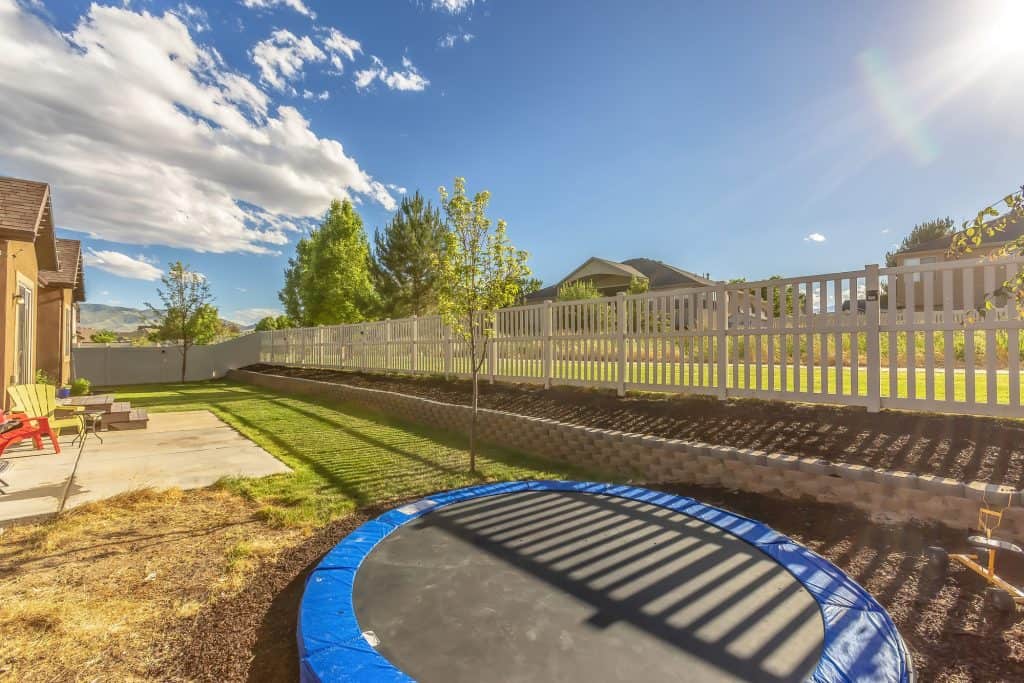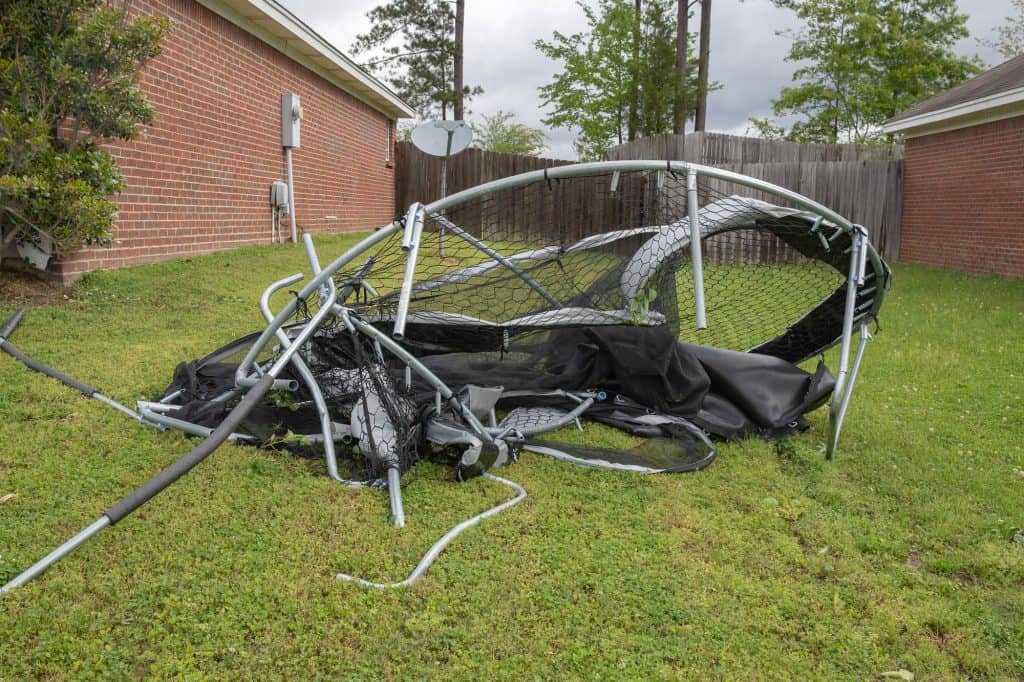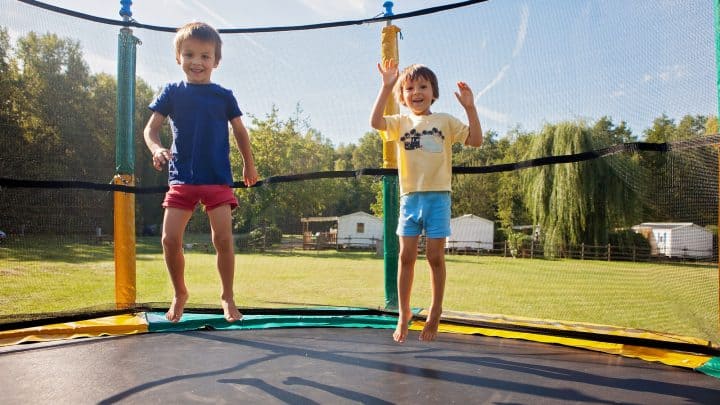If you’re thinking about getting a trampoline there’s one important decision you need to make: do you want an above-ground trampoline or an in-ground trampoline? This is an important question: everything from the price to installation specifics depends on which type you get.
Don’t worry, we’ll go over the main differences between owning an above-ground trampoline and an in-ground trampoline, and help go over the pros and cons so you can decide which type of trampoline is right for you.
In-ground trampolines are moderately safer, require more sophisticated installation, and are generally pricier than above-ground trampolines. Above-ground trampolines are generally cheaper, more versatile, and less permanent than in-ground trampolines.
We’re going to dive into the differences and some common questions folks have, so you can make an educated decision when buying either.
In-Ground Vs. Above-Ground: What’s The Difference?

At first, it might seem like the differences between these two types of trampolines is pretty obvious. An above-ground trampoline is designed to work standing on the ground or on another hard surface. It usually includes a safety enclosure and safety trim to help make sure you don’t accidentally fall off the side.
That means that above-ground trampolines are usually bulkier in your yard, and may have more connected parts to help keep them safe.
In-ground trampolines, on the other hand, have a much more streamlined profile, but take a lot more time to install. That’s because installing an in-ground trampoline requires digging a hole for the trampoline to sit in. Additionally, you may need proper drainage, a retaining wall, and other in-ground components to help keep the in-ground trampoline safe and durable.
For a step-by-step guide on how to install one, we wrote about that here.
There’s a lot that goes into both kinds of trampolines, and both are engineered to respond to the stress of use in different ways. That means that owners should think about the pros and cons of both models before they decide what kind they want.
However, it’s also important to consult with your HOA and homeowners insurance. Both organizations may have different fees for different kinds of trampolines, which can have a big impact on how practical each type of trampoline will be for you.
Pros And Cons Of Above-ground Trampolines
One of the primary advantages of above-ground trampolines is that they are a lot easier to install. All you need is a reasonably level surface and the stuff included in your trampoline kits — like the frame, mat, and safety nets.
Above-ground trampolines are also easier to move around, can be put away for the winter, and are easier to maintain than in-ground trampolines.
The last big advantage we want to highlight is that above-ground trampolines are also easier to get rid of when you aren’t using them anymore. Once your kids outgrow their trampoline you can easily pack it away (or sell or trash it, depending on the condition).
There are a few cons that come with above-ground trampolines though. For one thing, the frame has less support, which means they can move around more and are slightly more likely to be dangerous.
A lot of above-ground trampolines also don’t come with their safety netting. In-ground trampolines don’t often come with the nets either, but it’s more important for above-ground models. So, you’ll likely have to buy two kits to build a safe above-ground model, and you also need to check and make sure they’re compatible.
The last pro we want to address is that it’s easier to get a better bounce with an above-ground trampoline, but it is possible to get the same bounce from an in-ground trampoline.
The last con we want to address is wind.

High winds can sometimes turn above-ground trampolines into air-catching sails and can mean fewer days where it’s safe to use the trampoline at all. Stone blocks and other weights on the base can help, but in-ground trampolines are much safer when it comes to wind and windy areas.
Pros And Cons Of In-ground Trampolines
In-ground trampolines are gaining popularity (particularly in Utah), but there are definitely some pros and cons to their design.
One of the questions you should be asking before you decide on a trampoline is: Why do people put their trampolines in the ground?
People put their trampolines in the ground for three main reasons — safety, stability, and low-profile aesthetics. Most people’s concern is safety, but living in windy areas like the desert can make the increased stability and low-profile nature very attractive.
An in-ground trampoline with a good safety net is inherently safer when it comes to falls, but not necessarily in other respects. For one thing, in-ground trampolines make it harder to see potential problems under the trampoline, including issues like stagnant water, insect infestations, snakes (we wrote about how to keep them away here), and other wildlife.
However, they have the advantage of being more permanent, nearly impossible for wind to blow over, and closer to ground level (so falling isn’t as big of a deal).
Those advantages come at the cost of a more expensive installation, especially if you have a hard ground or need a storm drain under the trampoline. We wrote about the full cost of an in-ground trampoline installation here.

They take up a little less space once they are installed, but need extra space during installation for a retaining wall, extra room to make sure everything fits, and proper drainage.
Also, in-ground trampolines require some venting space for allowing air to leave while you jump. Otherwise, the air underneath creates some pressure that pushes back on the trampoline, reducing bounciness and forcing you to work harder to use the trampoline.
Which Kind Of Trampoline Is Right For You?
There’s no one clear way to decide what kind of trampoline is right for you, but there are some things you should think about while you’re deciding.
For instance, are you okay with renting equipment and taking the time to tear up your backyard and install an in-ground trampoline? Do you want to hire a contractor to do it instead, and if so, can you afford to do so?
Will your homeowner’s insurance go up if you have a visible above-ground trampoline, but not if you have a more subtle in-ground model?
If you have kids, how old are they, and can they be trusted to stay safe on an above-ground trampoline, or to check under an in-ground trampoline before using it?
Do you know how to build a retaining wall for your in-ground trampoline? Or would it be easier to stick to the frame from an above-ground model?
All of these questions can help you decide which type of trampoline is right for you, but only you can actually decide, in the end.
Common Questions
Here are some of the most common questions we see asked about in-ground and above-ground trampolines — along with the answers you need.
Is An In-Ground Trampoline Better?
Ultimately, the choice of which kind of trampoline is right for you is up to you and the limitations of your space. An above-ground trampoline is better if you don’t have a good digging location. An in-ground trampoline is better for small children and when above-ground trampolines aren’t an option.
Are In-Ground Trampolines As Bouncy As Above Ground Trampolines?
Generally, in-ground trampolines are as bouncy as above-ground trampolines, assuming they are installed properly. If ventilation is restricted, the bounce will be severely limited. This is because the person on the trampoline will be effectively jumping on a pocket of air.
Is It Safer To Bury Your Trampoline?
The reduced height of an in-ground trampoline generally makes them safer when falling off, but flooding and other hazards (like snakes) mean that there are other risks involved. All trampolines carry some amount of risk.
Can You Use An In-Ground Trampoline Above Ground?
In-ground trampolines are designed to work with a retaining wall and the surrounding ground. While you can bring them above the earth, the trampoline frame just won’t work as well or as safely above ground without heavy modification.
Can You Use An Above-Ground Trampoline In Ground?
While nothing is stopping you from burying an above-ground trampoline in the ground, they’re not designed for that purpose. An above-ground trampoline will likely have reduced airflow and the frame won’t be adequate for prolonged use below the earth.
How Long Do In-Ground Trampolines Last?
With care, in-ground trampolines can last between 5-10 years depending on a number of factors. The average life of an in-ground trampoline is 8 years and many in-ground trampoline companies offer 10+ year warranties on frames.

